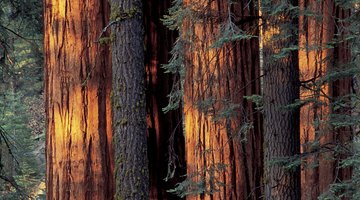Is Cedar Siding Better Than Redwood Siding?
Cedar and redwood can both be used as solid wood or shake siding. Solid wood, or lumber, siding is installed in long planks, while shake -- also known as shingle -- siding you install much like roof shingles, except to the side of a house.

Redwood and cedar siding are similar in many ways but have key differences that you should consider before installing.
Shared Characteristics
Both redwood and cedar are insect- and rot-resistant woods. They are not vulnerable to rot, mildew, mold or damage from wood-eating insects like termites. They tend to last longer and be more durable than siding made from nonresistant, soft woods such as fir or pine. Because of their insect- and weather-resistance, both can weather naturally without applying finishes or stains, which significantly reduces maintenance requirements over other types of wood siding. Homeowners can maintain the wood's initial natural color by applying a semitransparent, oil-based wood stain every three or four years.
Heartwood vs. Sapwood
While wood siding can last 75 years or more, this largely depends on proper maintenance and quality of the product. Quality redwood and cedar siding are entirely heartwood. Heartwood is found in the inner trunk of the tree and is where the majority of its insect- and rot-resistant compounds are found. Redwood and cedar sapwood sold as siding and other lumber products is found on the outer layers of the trunk and do not have as many of these compounds. Therefore, sapwood is not as resistant to these potential problems and sapwood siding can not be compared with heartwood siding. Likewise, sapwood products must be covered with a stain and water-repellent preservative to prevent rotting. When installing redwood or cedar siding, be sure you know which type of wood you have.
Costs
Redwood is the most expensive type of wood used for outdoor projects. It grows only in a narrow coastal strip on the West Coast, so the farther away you get from that area, the higher the price goes. It can be as much as four times the cost of pressure-treated lumber. Western red cedar, the most common weather and insect-resistant cedar used for outdoor building, has a wider growth area and is, on average, about half the cost of redwood and only twice the cost of pressure-treated lumber.
Environmental Considerations
The highest quality, most insect- and rot-resistant redwood comes from old growth trees. While an astoundingly durable, weather-resistant lumber, it comes at a cost. Only 5 percent of original old growth redwoods are still on the planet. The rest have already been logged -- including some of the tallest trees ever recorded. Second- and third-generation redwoods are a viable alternative, but they are not of the same quality. Cedar trees are more widespread and less endangered while sharing many of the same beneficial characteristics. In addition, cedar shake, bevel or lap siding made from sustainably harvested trees have the least overall environmental impact compared to any other popular siding choice.
References
Writer Bio
Elizabeth Jennings began publishing creative works in 1988 and has been a professional editor and writer since 2002. She holds a dual Bachelor of Arts in anthropology and philosophy.
Photo Credits
- Comstock/Comstock/Getty Images
- Comstock/Comstock/Getty Images
More Articles



